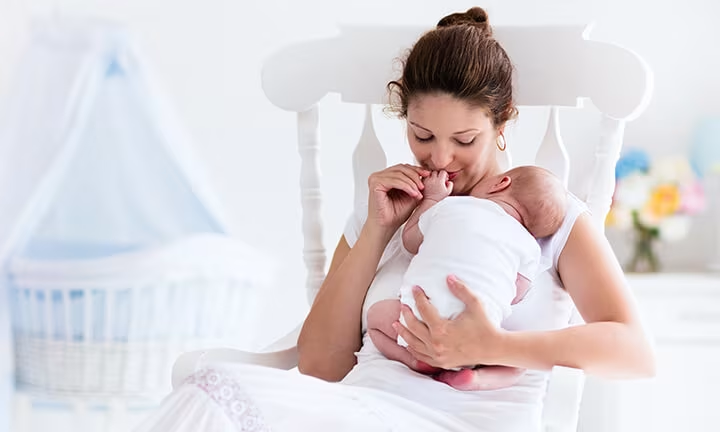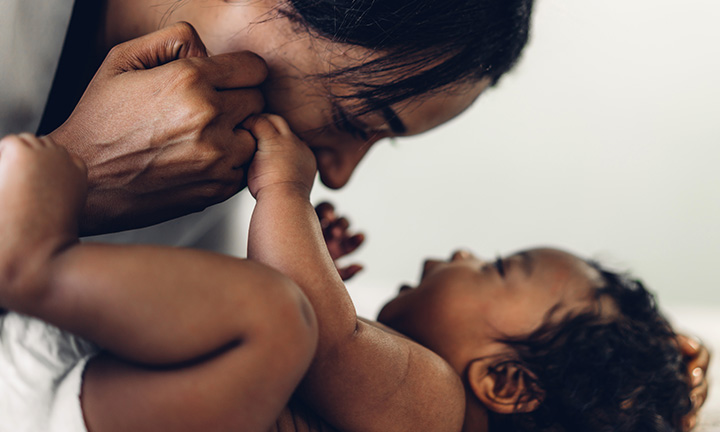
FAQ: Lochia (Postpartum Bleeding)
Lochia, sometimes referred to as postpartum bleeding, is the vaginal discharge that occurs after childbirth as the body sheds the uterine lining and heals. It’s a normal part of postpartum recovery, but many new parents are unsure what to expect. Lochia usually lasts between 4 to 6 weeks and changes in color and consistency over time. While it is typically harmless, understanding what is normal can help you identify signs of complications, such as heavy bleeding, a foul odor, or fever, which may require medical attention.
Here’s a quick overview of the lochia stages:
Understanding lochia helps you monitor your recovery and spot potential issues early. In this article, we’ll explore each stage in detail, what’s normal, what’s not, and when to call your healthcare provider.
What Is Lochia or Postpartum Bleeding?
Lochia is the vaginal discharge that occurs after childbirth. It happens whether you had a vaginal delivery or a C-section. But what is lochia exactly?
Lochia is the medical term for the postpartum bleeding and discharge that helps your body clear out everything it no longer needs from pregnancy. This includes blood, mucus, and tissue from the uterus, along with any remaining placental material. The meaning of lochia reflects this natural cleansing process—it's your body’s way of healing and returning the uterus to its pre-pregnancy state.
So, what causes lochia? After birth, the placenta separates from the uterine wall, leaving behind open blood vessels. As your uterus contracts to shrink back to its normal size, those vessels begin to heal, which leads to bleeding. This is why lochia postpartum is normal in the days and weeks after delivery.
Is Postpartum Bleeding Normal?
Yes, postpartum bleeding, or more precisely, lochia, is a normal part of recovery during the postpartum period. During this period, it’s common to experience lochia, which may include small blood clots, sometimes as large as a plum.
That said, it’s important to monitor your bleeding. If you find yourself soaking through two sanitary pads in less than an hour, or if you notice symptoms like pelvic pain, fever, or tenderness, reach out to your healthcare provider.
Postpartum Bleeding or Period?
Lochia and period bleeding may seem similar at first—both may start as dark red, heavy discharge with a noticeable smell. But what’s the difference between postpartum bleeding and a period? Postpartum bleeding lasts much longer, often up to six weeks, while a period typically lasts about a week. Lochia may also contain blood clots as large as a plum, which isn’t common with period bleeding.
If you’re unsure whether you’re experiencing postpartum bleeding or period bleeding, consider the timing—lochia begins right after childbirth, while period bleeding returns weeks or months later.
As you navigate the early days of postpartum recovery—including managing lochia—it’s normal to have many questions about what’s happening to your body, how to care for your baby, and what to expect next. For a more comprehensive overview of what to expect in the first weeks and months, our New Parents Guide can help you feel more prepared and supported every step of the way.
How to Identify Lochia?
Lochia goes through distinct stages, and both its color and volume change as your body heals. In the first few days after childbirth, postpartum bleeding usually presents as bright or dark red discharge, which can be heavy enough to soak a thick pad every two to three hours. It's normal to pass small blood clots following labor, although they should generally be small in size.
Around a week later, lochia becomes lighter and takes on a pinkish or brown discharge. By the second week, the flow decreases further, transitioning to a yellowish discharge or a pale, yellow discharge. Some people may only need thin liners at this stage.
Does Lochia Have a Smell?
If you’re wondering, “Does lochia smell?” you’re not alone. It’s normal for postpartum bleeding to have a mild scent, often described as similar to menstrual blood, slightly musty or metallic. This lochia smell is expected and not usually a cause for concern.
However, if the vaginal smell postpartum becomes strong, foul, or fishy, it could indicate an infection. A postpartum discharge smell that seems unusual, especially if it's paired with fever, chills, or abdominal pain, should be checked by your healthcare provider.
To help prevent an unpleasant smell from your postpartum bleeding after giving birth, change your pads frequently and avoid using tampons, as they can introduce bacteria and interfere with healing.
When Does Lochia Start After a Vaginal Birth?
Lochia, or postpartum bleeding, generally begins immediately after childbirth, right after the placenta is delivered. So, if you're wondering, "When does lochia start?" the answer is: it starts right away, even while you're still in the hospital. This is your body’s way of clearing out the blood and tissue that supported your baby during pregnancy.
For first-time parents, it can be surprising how heavy the bleeding after birth is in those first few days. This early phase may include bright red blood and small clots. Over time, the bleeding becomes lighter and changes color, usually turning pink, brown, and eventually yellowish-white as healing progresses.
How Long Does Postpartum Bleeding (Lochia) Last?
Wondering, "How long does lochia last?" or "For how long do you bleed after giving birth?" Most people experience postpartum bleeding for about four to six weeks, but the timeline can vary depending on factors like your body’s healing process.
Some new parents may notice that bleeding stops after two or three weeks, while others may see light postpartum discharge or spotting continue beyond the one-month mark.
So, how long does bleeding last after birth if breastfeeding? It may be a bit shorter, but there’s a wide range of normal. The most important thing is that the flow gradually decreases. If it becomes heavier or smells foul, check in with your provider to rule out infection or other complications.
What Are the Stages of Lochia?
Lochia progresses in three postpartum bleeding stages as your body heals:
These lochia stages mark normal postpartum recovery. If bleeding suddenly increases or changes, consult your healthcare provider.
Can Postpartum Bleeding Stop and Start Again?
Although there may be times when you notice more or less discharge, lochia itself doesn't usually stop altogether, only to start up again. The postpartum bleeding usually stops within 4 to 6 weeks after childbirth.
If you’ve noticed that your bleeding after a vaginal birth or c-section stopped and then started again with bright red blood/discharge, it might be the return of your period or a complication. It’s recommended to contact your healthcare provider for more advice.
Lochia After a C-Section
Lochia after a cesarean delivery is similar to what happens after a vaginal birth, though the bleeding may be lighter. While bleeding after a c-section may taper off sooner than with a vaginal delivery, light spotting may persist for several weeks. If you’re unsure how long you should bleed after a c-section or you notice prolonged or heavy bleeding, consult your healthcare provider.
How to Manage Lochia at Home
Managing postpartum bleeding helps support healing. Here’s how to care for yourself during this time:
If bleeding worsens or lasts longer than expected, consult your healthcare provider.
Postpartum Bleeding After Intercourse
Bleeding after sex postpartum may occur if intercourse resumes too soon. Healthcare providers recommend waiting at least six weeks to allow for healing. Light bleeding after postpartum intercourse is common, but heavy or persistent bleeding after sex after giving birth could indicate irritation or infection. Contact your provider if bleeding continues.
When to Consult Your Healthcare Provider
Contact your healthcare provider if you notice symptoms of postpartum infection or if your lochia appears abnormal. If you have a lochia infection, you may notice the following symptoms:
If you’re unsure whether it’s normal lochia or an infection, pay attention to changes in color, flow, or odor. Postpartum lochia infection may lead to complications, so seek medical care if you suspect anything unusual.
The Bottom Line
Postpartum bleeding can be inconvenient, but it’s a normal and temporary part of recovery. Keeping pads on hand and using more absorbent options at night can help manage a heavier flow. Your body is healing from pregnancy and childbirth, and these changes take time.
During this period, balancing recovery with newborn care may feel overwhelming. If you're unsure about what's normal or need reassurance, don’t hesitate to reach out to your healthcare provider. Lean on your partner or loved ones for support when needed.
To earn savings on your future diaper purchases, download the Pampers Rewards app. Every little bit helps during this busy time. Every little bit of savings can make a difference during this busy time.
- American College of Obstetricians and Gynecologists. Your Pregnancy and Childbirth: Month to Month, 7th ed. (Washington, DC: American College of Obstetricians and Gynecologists, 2021).
- Cleveland Clinic. "Lochia."
- Cleveland Clinic. "Pregnancy: Physical Changes After Delivery."
Read more about Baby
Related Articles
Join a World of Support
through Pregnancy and Parenthood.








